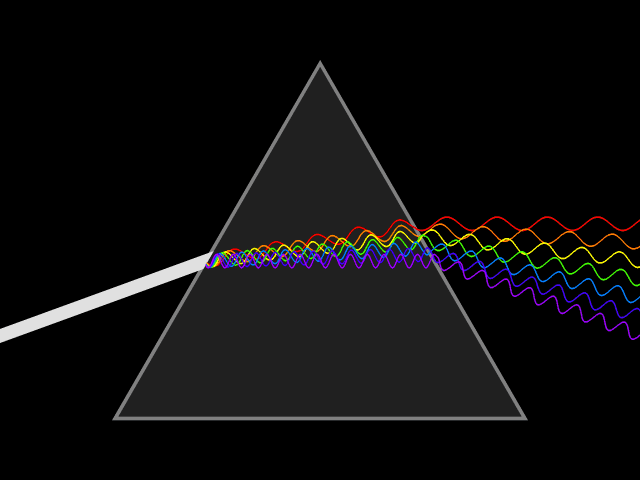




4 - 5
<
>
PHOTONe
2015: International Year of Light





Colour picture made by overlaying 3 channels.
The Emir of Bukhara in a 1911 color photograph
Solar Panels
Cone receptivity of Wavelengths.
Splitting of light by a prism
<
>
Many hail the wheel as man’s first and most significant step towards science and progress in general. I, instead, choose to believe it was fire. While other species had to rely on the Sun, the moon, and occasionally, a gene causing bioluminescence for light, we were very likely the first Earthly species to have created our own source of light. Since then, light has become somewhat synonymous with ingenuity, epiphany, and perhaps science in general, be it through lingual additions such as ‘enlightenment’ and ‘illumination’, to the ubiquitous image of a light-bulb on top of the head, representing an idea.
However, despite the fact that we’ve known about light for just about as long as our species has been alive, we know so little about it. For example, until relatively recently, and by that I mean about 150 years ago, we thought light was just individual particles. Then we thought it was in fact a wave of some sort. And as of now, we believe it’s both. Or at-least, it behaves like both, depending on the experiment. Now considering that we know so little about light, despite it being an integral part of our lives, I thought I’d try and examine it from three different perspectives, i.e. from a physical perspective, and chemical perspective, and a biological perspective. So here goes:
Physically, light, or the part of it we can detect with our eyes, is simply a tiny slice of the electromagnetic spectrum. Visible light ranges between a wavelength of 400 to 750 nanometers. Higher than that, you have infrared, microwave, and fm waves, and lower than that, you have UV and x-rays. The visible portion of light consists of 7 distinct bands which we can detect, which constitute the colours of a rainbow. Now a wave, is basically a transfer of energy, which means light possesses energy. This is the driving force behind processes such as photosynthesis. However, we too can harness this energy, to generate electricity, which is the premise behind solar panels.
An interesting chemical aspect of light is photography. When the first cameras were made, there were basically just a few lenses and a plate covered with chemicals such as Silver Bromide. Such chemicals, which were dark initially, when exposed to light, would decompose to Silver and Bromine. This would leave a light patch at the point exposed to light. When the lenses focused an entire image on the plate, due to the varying intensities and wavelengths of the light reflected off the subject, different portions of the plate would get exposed differently, forming a simple black and white photograph.
Colour photography, on the other hand, was a whole-another ball game. Which brings me to the biological aspect of light. We detect light through our eyes, which I’m guessing you already knew. How we do so, is through sensory cells in our retina, and a little processing by the brain. Our retina possesses two basic types of sensory cells, cone cell and rod cells. Cone cells detect high intensity light, and colour. There are three main types of cone cells, those that best detect short wavelength light, those that best detect medium wavelength light, and those that best detect long wavelength light.
All the wavelengths in between stimulate either one, two or all three of the types of cone cells to a certain extent. This data is sent to the brain to process and output colours. This was first practically noticed by few, such as James Maxwell(same guy who said light behaved like a wave), who proved that you can generate any colour using only red, green, and blue paint in varying proportions. He did so by painting kind of pie charts using only red, blue and green with various percentages, and spinning this board really fast. What he did, in effect, was stimulate all the cone cells in the same proportion a certain colour would, but not give the brain enough time to process that these were three separate colours, not one. He chose red, blue, and green, because blue has a short wavelength, green has medium, and red has long. This led to colour photography, where three different plates would be exposed to the same image, but through red, blue and green filters respectively, after which they would be superimposed through those same filters, to form a coherent colour image. This still has practical application today, in devices such as printers, and in LCD and LED screens. Printers can’t afford to be loaded with every different colour, so instead they posses only a few colours, and when they print many tiny dots of each of these colours in a certain proportion, they can generate any colour by tricking our brain.
I’ll conclude with something interesting you can do at home. Humans, as I said, can only perceive light between the wavelengths 400-750nm. However, the chip in your phone camera can go a little beyond our spectrum, and your phone’s screen can’t. This disparity allows us to see beyond our spectrum. For example, whenever you click your TV remote, it sends an electromagnetic wave as a signal, and it is usually out of our spectrum. But if you turn on your phone camera and point it towards the front of your remote, and click a button on the remote, you can actually see the wave as a whitish light. You will effectively be able to see beyond our spectrum.
ONe
ISSUE XVII